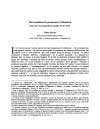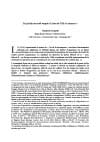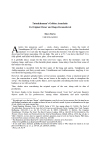Akhenaton
« Deux mentions du prænomen d’AkhĂ©naton dans une encyclopĂ©die byzantine du Xe siècle »
ENiM 5, 2012, p. 115-117.
 L’encyclopédie byzantine de Suidas (Souda), du Xe siècle, nous offre, sous la forme « Nephersôphris », la seule attestation connue du prænomen d’Akhénaton dans les sources grecques. Cette mention de l’hérétique en plein Moyen-Âge, prenant l’aspect d’un court proverbe évoquant sa légende noire, prouve que le souvenir du pharaon d’Amarna avait bel et bien survécu, de manière obscure, à travers plus de deux mille ans d’histoire.
L’encyclopédie byzantine de Suidas (Souda), du Xe siècle, nous offre, sous la forme « Nephersôphris », la seule attestation connue du prænomen d’Akhénaton dans les sources grecques. Cette mention de l’hérétique en plein Moyen-Âge, prenant l’aspect d’un court proverbe évoquant sa légende noire, prouve que le souvenir du pharaon d’Amarna avait bel et bien survécu, de manière obscure, à travers plus de deux mille ans d’histoire.
 The Suda, a 10th century Byzantine encyclopedia, provides us with the only mention of Akhenaten’s praenomen in Greek sources (Nephersophris = Neferkheperura). This evocation of the heretical king, in the shape of a proverb focusing on the unlucky power of his name, proves that Akhenaten’s dark memory had survived by some unknown ways, over more than 2000 years.
The Suda, a 10th century Byzantine encyclopedia, provides us with the only mention of Akhenaten’s praenomen in Greek sources (Nephersophris = Neferkheperura). This evocation of the heretical king, in the shape of a proverb focusing on the unlucky power of his name, proves that Akhenaten’s dark memory had survived by some unknown ways, over more than 2000 years.
 Consulter cet article (48224) -
Consulter cet article (48224) -  Télécharger cet article au format pdf (27661)
Télécharger cet article au format pdf (27661)
« L’ADN de la famille royale amarnienne et les sources Ă©gyptiennes. De la complĂ©mentaritĂ© des mĂ©thodes et des rĂ©sultats »
ENiM 6, 2013, p. 177-203.
 Les enquêtes menées sur l’ADN des momies royales publiées en 2010 ont fourni des matériaux pour un nouvel arbre généalogique de la famille royales de la fin de la XVIIIe dynastie. Après avoir discuté de la fiabilité de ces études, un examen approfondi des résultats conduit à la conclusion que certains liens de parenté révélés par l’ADN ont échappé à l’équipe de généticiens. Le plus significatif de ceux-ci consiste dans le fait que Youya partage avec son gendre Amenhotep III environ 1/3 de son patrimoine génétique. Il est proposé, en conséquence, que Youya ait été un oncle d’Amenhotep III, ce qui signifie que Tiyi était une cousine germaine de son mari. En extrapolant pour la génération suivante, on suggère qu’Amenhotep IV – Akhenaton a également épousée sa propre cousine, Nefertiti, dont les parents étaient liées à la fois à Youya et Amenhotep III. Ceci expliquerait pourquoi l’ADN d’Amenhotep IV – Akhenaton (momie de KV 55) et celui de Nefertiti, identifiée, à la Young Lady de la tombe d’Amenhotep II (KV35YL) aient pu sembler ceux d’un frère et d’une sœur. En accord avec les témoignages écrits de nouveau examinés en détail, Toutankhamon est considéré comme le septième et dernier enfant d’Amenhotep IV – Akhenaton et Nefertiti et, de son côté, la momie KV21A est donnée comme vraisemblablement celle de Moutemouiya. Un nouvel arbre généalogique, fondé sur ces données ADN et épigraphiques est proposé en conclusion.
Les enquêtes menées sur l’ADN des momies royales publiées en 2010 ont fourni des matériaux pour un nouvel arbre généalogique de la famille royales de la fin de la XVIIIe dynastie. Après avoir discuté de la fiabilité de ces études, un examen approfondi des résultats conduit à la conclusion que certains liens de parenté révélés par l’ADN ont échappé à l’équipe de généticiens. Le plus significatif de ceux-ci consiste dans le fait que Youya partage avec son gendre Amenhotep III environ 1/3 de son patrimoine génétique. Il est proposé, en conséquence, que Youya ait été un oncle d’Amenhotep III, ce qui signifie que Tiyi était une cousine germaine de son mari. En extrapolant pour la génération suivante, on suggère qu’Amenhotep IV – Akhenaton a également épousée sa propre cousine, Nefertiti, dont les parents étaient liées à la fois à Youya et Amenhotep III. Ceci expliquerait pourquoi l’ADN d’Amenhotep IV – Akhenaton (momie de KV 55) et celui de Nefertiti, identifiée, à la Young Lady de la tombe d’Amenhotep II (KV35YL) aient pu sembler ceux d’un frère et d’une sœur. En accord avec les témoignages écrits de nouveau examinés en détail, Toutankhamon est considéré comme le septième et dernier enfant d’Amenhotep IV – Akhenaton et Nefertiti et, de son côté, la momie KV21A est donnée comme vraisemblablement celle de Moutemouiya. Un nouvel arbre généalogique, fondé sur ces données ADN et épigraphiques est proposé en conclusion.
 The investigations carried on the DNA of the royal mummies published in february 2010 have provided material for a new genealogical tree for the royal family of the late XVIIInth dynasty. After discussing the reliability of this study, a close examination of these results leads to the conclusion that some genetical links excaped to the team of geneticians. The most significant being the fact that Yuya shares with his son-in-law Amenhotep III about 1/3 of genetical inheritance. It is consequently proposed that Yuya was an uncle of Amenhotep III, Mutemwiya being his sister. This means that queen Tiyi was in fact an actual cousin of Amenhotep III. Extrapolating to the next generation it is also suggested that Amenhotep IV – Akhenaten equally married his own cousin, Nefertiti, whose parents were related to both Amenhotep III and Yuya. This would explain why the DNA of Amenhotep IV – Akhenaten (mummy KV 55) and that of Nefertiti, identified to mummy KV 35 YL, were looking like that of siblings. It is also suggested that Tutankhamun was the seventh child of Amenhotep IV – Akhenaten and Nefertiti in accordance with some reappraised epigraphic evidences, and that Mutemwiya is no other than the mummy KV21A. A new genealogical tree based on DNA and epigraphic data is given in conclusion.
The investigations carried on the DNA of the royal mummies published in february 2010 have provided material for a new genealogical tree for the royal family of the late XVIIInth dynasty. After discussing the reliability of this study, a close examination of these results leads to the conclusion that some genetical links excaped to the team of geneticians. The most significant being the fact that Yuya shares with his son-in-law Amenhotep III about 1/3 of genetical inheritance. It is consequently proposed that Yuya was an uncle of Amenhotep III, Mutemwiya being his sister. This means that queen Tiyi was in fact an actual cousin of Amenhotep III. Extrapolating to the next generation it is also suggested that Amenhotep IV – Akhenaten equally married his own cousin, Nefertiti, whose parents were related to both Amenhotep III and Yuya. This would explain why the DNA of Amenhotep IV – Akhenaten (mummy KV 55) and that of Nefertiti, identified to mummy KV 35 YL, were looking like that of siblings. It is also suggested that Tutankhamun was the seventh child of Amenhotep IV – Akhenaten and Nefertiti in accordance with some reappraised epigraphic evidences, and that Mutemwiya is no other than the mummy KV21A. A new genealogical tree based on DNA and epigraphic data is given in conclusion.
 Consulter cet article (56703) -
Consulter cet article (56703) -  Télécharger cet article au format pdf (30078)
Télécharger cet article au format pdf (30078)
« Un jardin au petit temple d’Aton de Tell el-Amarna ? »
ENiM 6, 2013, p. 205-231.
 Cet article présente l’hypothèse selon laquelle il aurait existé devant le petit temple d’Aton, une cour arborée agrémentée d’un bassin en forme de T renversé, aménagement démantelé pour laisser place sous le règne d’Ânkhkhépérourê au supposé Coronation Hall dit de « Smenkhkarê ».
La démonstration se fonde sur deux études comparées dont les résultats ont été confrontés : celle des scènes de remise de « l’or de la récompense » aux fonctionnaires méritants par Akhénaton et Néfertiti et celle des représentations architecturales de temples dans les tombes amarniennes avec les plans des monuments de culte atoniste eux-mêmes et les faits archéologiques.
L’article s’achève par un essai de reconstitution de cet état supposé du petit temple illustré par des modèles numériques.
Cet article présente l’hypothèse selon laquelle il aurait existé devant le petit temple d’Aton, une cour arborée agrémentée d’un bassin en forme de T renversé, aménagement démantelé pour laisser place sous le règne d’Ânkhkhépérourê au supposé Coronation Hall dit de « Smenkhkarê ».
La démonstration se fonde sur deux études comparées dont les résultats ont été confrontés : celle des scènes de remise de « l’or de la récompense » aux fonctionnaires méritants par Akhénaton et Néfertiti et celle des représentations architecturales de temples dans les tombes amarniennes avec les plans des monuments de culte atoniste eux-mêmes et les faits archéologiques.
L’article s’achève par un essai de reconstitution de cet état supposé du petit temple illustré par des modèles numériques.
 This article presents the hypothesis that there was a leafy courtyard with a pool in the shape of an inverted T in front of the small Aten temple. Under the reign of Ă‚nkheperurĂŞ, this courtyard may have been dismantled to make way for the presumed Coronation Hall also known as SmenkhkarĂŞ Hall.
The demonstration is based on two comparative studies: between the rewarding scenes which show the distribution of the « gold of honour » by Akhenaten and Nefertiti, and between the architectural representations of temples from the Amarna tombs with the plans of the Aten temples themselves and archaeological facts.
The article ends with an attempt to rebuild this supposed state of the Small Aten temple by means of digital models.
This article presents the hypothesis that there was a leafy courtyard with a pool in the shape of an inverted T in front of the small Aten temple. Under the reign of Ă‚nkheperurĂŞ, this courtyard may have been dismantled to make way for the presumed Coronation Hall also known as SmenkhkarĂŞ Hall.
The demonstration is based on two comparative studies: between the rewarding scenes which show the distribution of the « gold of honour » by Akhenaten and Nefertiti, and between the architectural representations of temples from the Amarna tombs with the plans of the Aten temples themselves and archaeological facts.
The article ends with an attempt to rebuild this supposed state of the Small Aten temple by means of digital models.
 Consulter cet article (53298) -
Consulter cet article (53298) -  Télécharger cet article au format pdf (27045)
Télécharger cet article au format pdf (27045)
« Tutankhamun’s Golden Armchair: Its Original Owner and Shape Reconsidered »
ENiM 14, 2021, p. 273-284.
 Il est généralement admis que le fauteuil doré léontocéphale de la tombe de Toutânkhamon a été fabriqué pour ce roi, au début de son règne. Cependant, certains auteurs, qui ont étudié la scène atonienne sur le dossier, pensent que le siège a appartenu à un précédent roi amarnien. Dans cette étude, nous proposons deux nouvelles analyses afin d’identifier le propriétaire originel : le contexte typologique et l’iconographie globale. Ces deux approches nous permettent également de reconsidérer la forme originelle du siège. Nous démontrons ainsi que le fauteuil léontocéphale de Toutânkhamon a appartenu à un précédent roi, probablement Akhenaton, et qu’il s’agissait d’une simple chaise léonine, typique de la période amarnienne.
Il est généralement admis que le fauteuil doré léontocéphale de la tombe de Toutânkhamon a été fabriqué pour ce roi, au début de son règne. Cependant, certains auteurs, qui ont étudié la scène atonienne sur le dossier, pensent que le siège a appartenu à un précédent roi amarnien. Dans cette étude, nous proposons deux nouvelles analyses afin d’identifier le propriétaire originel : le contexte typologique et l’iconographie globale. Ces deux approches nous permettent également de reconsidérer la forme originelle du siège. Nous démontrons ainsi que le fauteuil léontocéphale de Toutânkhamon a appartenu à un précédent roi, probablement Akhenaton, et qu’il s’agissait d’une simple chaise léonine, typique de la période amarnienne.
 It is often admitted that the lion-headed golden armchair from the tomb of Tutankhamun was made for this king, at the beginning of his reign. However, some authors, who studied the Atenist scene on the backrest, think the seat belonged to a previous Amarna king. In this study, we propose two more analyses in order to identify the original owner of the armchair: the typological context and the global iconography. These two approaches allow us to reconsider the original shape of the seat, too. We show that Tutankhamun’s lion-headed armchair belonged to a previous king, most probably Akhenaten, and that it was a simple lion-legged chair, typical of the Amarna period.
It is often admitted that the lion-headed golden armchair from the tomb of Tutankhamun was made for this king, at the beginning of his reign. However, some authors, who studied the Atenist scene on the backrest, think the seat belonged to a previous Amarna king. In this study, we propose two more analyses in order to identify the original owner of the armchair: the typological context and the global iconography. These two approaches allow us to reconsider the original shape of the seat, too. We show that Tutankhamun’s lion-headed armchair belonged to a previous king, most probably Akhenaten, and that it was a simple lion-legged chair, typical of the Amarna period.
 Consulter cet article (39060) -
Consulter cet article (39060) -  Télécharger cet article au format pdf (19841)
Télécharger cet article au format pdf (19841)
ENiM 18 - 2025
8 article(s) - 8 octobre 2025.
ENiM 1 à 18 (2008-2025) : 227 articles
5 246 994 téléchargements
10 480 155 consulations.
Index des auteurs

Mots clés

Derniers articles : 
CENiM - Mise en ligne des volumes Ă©puisĂ©s : 
 Anne-Sophie von BOMHARD DĂ©cans Ă©gyptiens, CENiM 23, Montpellier, 2020 — (2020)
Anne-Sophie von BOMHARD DĂ©cans Ă©gyptiens, CENiM 23, Montpellier, 2020 — (2020) 
 Jean-Claude Grenier L'Osiris ANTINOOS, CENiM 1, Montpellier, 2008 — (26 dĂ©cembre 2008)
Jean-Claude Grenier L'Osiris ANTINOOS, CENiM 1, Montpellier, 2008 — (26 dĂ©cembre 2008) 
TDENiM - Mise en ligne des volumes Ă©puisĂ©s : 
 Twitter
Twitter 4181935 visites - 6347 visite(s) aujourd’hui - 191 connecté(s)
© ENiM - Une revue d’égyptologie sur internet
Équipe Égypte Nilotique et Méditerranéenne - UMR 5140 - « Archéologie des Sociétés Méditerranéennes » (Cnrs) - Université Paul Valéry - Montpellier III

























 Contact
Contact
 Abonnez-vous !
Abonnez-vous ! Équipe Égypte Nilotique et Méditerranéenne
Équipe Égypte Nilotique et Méditerranéenne UMR 5140 « Archéologie des Sociétés Méditerranéennes » (Cnrs)
UMR 5140 « Archéologie des Sociétés Méditerranéennes » (Cnrs) Université Paul Valéry - Montpellier III
Université Paul Valéry - Montpellier III